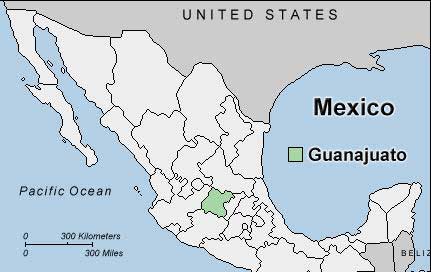Valle de Santiago is located in the state of Guanjuato, a state located in the center of Mexico. It’s capital is the beautiful city of Guanajuato (yes, same name), and it has quite a few pueblo magicos and beautiful touristy locations around the state. Here are five more things about Guanjuato as a whole!

1. The reputation of Guanajuato is that we’re a bunch of mochos – uptight Catholics. Now, I don’t know how much that is true, but the majority of the people here are predominantly homogeneous, non-indigenous, and catholic. The religious side of Guanajuato comes out through its abortion legislature – Guanajuato has one of the strictest laws against abortion in the country. It’s one of three states to ban it in all circumstances, and there have been cases where police have investigated women with miscarriages in hospitals under the suspicion that they induced their own abortions.
2. Like I just mentioned, Guanajuato also has one of the lowest indigenous populations in Mexico, which makes for a type of homogeneity, and also a lot of white looking people. If some of my friends went to the US, people would probably think they’re of Italian or European descent. (Just another reason why racial categories DON’T make sense, because not all Mexicans are short and tan, unlike media perceptions). Compare my state to the state of Chiapas (which has one of the high indigenous populations in Mexico), for example, and the differences become stark.
3. Primary industries here are agriculture and factory-based. There are a lot of farms here, and Guanajuato actually produces some of the largest numbers of migrant farm workers who come to America with experience working on Mexican farms. There are a lot of Toyota, Ford, and Mazda companies here as well factories like Dannon (the yogurt company), Colgate. I’ll go into Mexican education in another cositas post, but it is because of the many manufacturers in this state that many of the students in my school train in majors like food science or agricultural engineering to prepare to work in the factories that are here.
4. Historially, Guanjuato is known for being the “cradle of Mexican independence.” It is here that many of the first revolutions against the Spanish were started. The iconic grito de la independencia by Miguel Hidalgo took place in Dolores Hidalgo, and the anniversary of that day is Mexican Independence Day, September 15th. There are a lot more historical sites in Guanajuato that have to do with Mexican independence as well.
5. Smaller ethnic populations here are surprisingly, Asian! Every time I go to the immigration office, I make eye contact with Asian people who look like me. Because of the Toyota and Mazda factories that are here, Japanese people make up a significant subpopulation in Guanjauto. When you go to bigger cities like Irapuato, there are actually signs written in Japanese as well as Spanish, which was super surprising the first time I saw it! The Korean and Chinese populations are significantly smaller, but it was pleasantly surprising for me to realize that a few number of Mexicans here have actually worked with Asian people before. Immigrations patterns are fascinating!
This is the overall vibe of Guanjuato, I would say. After visiting the south of Mexico, I know how different Mexican culture can be depending on the part of the country you’re in, but I’m glad to be experiencing this one! In general, people say that people in Central Mexico are less warm and less open than people by, say, the coastline or the south (a stereotype that also exists in America, funnily enough), but I’ve had nothing but good experiences in my town. I can definitely see, however, how larger industrialized cities in Central Mexico could be much more intimidating places.
And thinking about all of the places I could have ended up this Fulbright year, really makes me amazed at how grand Mexico is. If I had been in a big city in Yucatan, or a small pueblo in Hidalgo, or a beach town in Quintana Roo, or Mexico City, my experience would have been completely different. The Mexico I have come to know and love is largely based in my experiences in my one town of Valle de Santiago, located in the singular state of Guanajuato. So if you’re reading this, I just want you to know how huge, how diverse, and how different Mexico can be. There is no one Mexico.
And if you’re a future Fulbrighter who’s reading this, I want you to know – there is no way you’ll learn everything there is to know about Mexico in one year. But do your best, and you’ll leave this country much wiser than you were going in.
